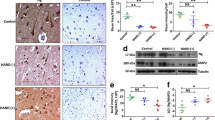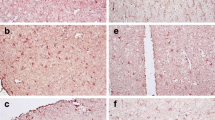Abstract
Sestrin-2 is involved in p53-dependent antioxidant defenses and in the maintenance of metabolic homeostasis. We hypothesize that sestrin-2 expression is altered in the brains of subjects diagnosed with human immunodeficiency virus (HIV)-associated neurocognitive disorders (HAND) due to neuronal oxidative stress. We studied sestrin-2 immunoreactivity in 42 isocortex sections from HIV-1-infected subjects compared to 18 age-matched non-HIV controls and 19 advanced Alzheimer’s disease (AD) cases. With HIV infection, the sestrin-2 immunoreactivity pattern shifted from neuropil predominance (N) to neuropil and neuronal-soma co-dominance (NS) and neuronal-soma predominance (S; P < 0.0001, Chi-square test for linear trend). Among HIV cases showing the NS or S pattern, HAND cases were preferentially associated with the S pattern (n = 10 of 20) compared to cognitively intact cases (n = 1 of 11; P = 0.047, Fisher’s exact test). In AD brains, sestrin-2 immunoreactivity was mostly intense in the neuropil and co-localized with phospho-Tau immunoreactivity in a subset of neurofibrillary lesions. Phospho-Tau-immunoreactive neurofibrillary lesions were rare in HIV cases and their occurrence was not associated with HAND. Levels of isocortical 8-hydroxy-deoxyguanosine (marker of nucleic acid oxidation) immunoreactivity were not significantly altered in HAND cases compared to cognitively intact HIV cases. In conclusion, the sestrin-2 immunoreactivity redistribution to neuronal soma in HAND suggests unique involvement of sestrin-2 in the pathophysiology of HAND, which is different from the role of sestrin-2 in AD pathogenesis. Alternatively, the difference in sestrin-2 immunoreactivity distribution between HAND and AD may be related to different degrees of severity or stages of oxidative stress.




Similar content being viewed by others
References
Aksenov MY, Hasselrot U, Bansal AK et al (2001) Oxidative damage induced by the injection of HIV-1 Tat protein in the rat striatum. Neurosci Lett 305:5–8
Alafuzoff I, Arzberger T, Al-Sarraj S et al (2008) Staging of neurofibrillary pathology in Alzheimer’s disease: a study of the BrainNet Europe Consortium. Brain Pathol 18:484–496
Altman DG (1991) Comparing groups–categorical data. In: Practical statistics for medical research, 1st edn. Chapman and Hall, London, pp 261–265
Antinori A, Arendt G, Becker JT et al (2007) Updated research nosology for HIV-associated neurocognitive disorders. Neurology 69:1789–1799
Bandaru VV, McArthur JC, Sacktor N, Cutler RG, Knapp EL, Mattson MP, Haughey NJ (2007) Associative and predictive biomarkers of dementia in HIV-1-infected patients. Neurology 68:1481–1487
Budanov AV (2011) Stress-responsive sestrins link p53 with redox regulation and mammalian target of rapamycin signaling. Antioxid Redox Signal 15:1679–1690
Budanov AV, Karin M (2008) p53 target genes sestrin1 and sestrin2 connect genotoxic stress and mTOR signaling. Cell 134:451–460
Budanov AV, Shoshani T, Faerman A et al (2002) Identification of a novel stress-responsive gene Hi95 involved in regulation of cell viability. Oncogene 21:6017–6031
Budanov AV, Sablina AA, Feinstein E, Koonin EV, Chumakov PM (2004) Regeneration of peroxiredoxins by p53-regulated sestrins, homologs of bacterial AhpD. Science 304(5670):596–600
Deshmane SL, Mukerjee R, Fan S et al (2009) Activation of the oxidative stress pathway by HIV-1 Vpr leads to induction of hypoxia-inducible factor 1alpha expression. J Biol Chem 284:11364–11373
Furuta A, Price DL, Pardo CA, Troncoso JC, Xu ZS, Taniguchi N, Martin LJ (1995) Localization of superoxide dismutases in Alzheimer’s disease and Down’s syndrome neocortex and hippocampus. Am J Pathol 146:357–367
Gearing M, Mirra SS, Hedreen JC, Sumi SM, Hansen LA, Heyman A (1995) The Consortium to Establish a Registry for Alzheimer’s Disease (CERAD). Part X. Neuropathology confirmation of the clinical diagnosis of Alzheimer’s disease. Neurology 45:461–466
Hasin DS, Trautman KD, Miele GM, Samet S, Smith M, Endicott J (1996) Psychiatric Research Interview for Substance and Mental Disorders (PRISM): reliability for substance abusers. Am J Psychiatry 153:1195–1201
Haughey NJ, Cutler RG, Tamara A et al (2004) Perturbation of sphingolipid metabolism and ceramide production in HIV-dementia. Ann Neurol 55:257–267
Heaton RK, Franklin DR, Ellis RJ et al (2011) HIV-associated neurocognitive disorders before and during the era of combination antiretroviral therapy: differences in rates, nature, and predictors. J Neurovirol 17:3–16
Jayadev S, Garden GA (2009) Host and viral factors influencing the pathogenesis of HIV-associated neurocognitive disorders. J Neuroimmune Pharmacol 4:175–189
Kruman II, Nath A, Mattson MP (1998) HIV-1 protein Tat induces apoptosis of hippocampal neurons by a mechanism involving caspase activation, calcium overload, and oxidative stress. Exp Neurol 154:276–288
Lee HP, Zhu X, Casadesus G et al (2010a) Antioxidant approaches for the treatment of Alzheimer’s disease. Expert Rev Neurother 10:1201–1208
Lee JH, Budanov AV, Park EJ et al (2010b) Sestrin as a feedback inhibitor of TOR that prevents age-related pathologies. Science 327(5970):1223–1228
Levine AJ, Hinkin CH, Ando K et al (2008) An exploratory study of long-term neurocognitive outcomes following recovery from opportunistic brain infections in HIV+ adults. J Clin Exp Neuropsychol 30:836–843
Li W, Malpica-Llanos TM, Gundry R, Cotter RJ, Sacktor N, McArthur J, Nath A (2008) Nitrosative stress with HIV dementia causes decreased L-prostaglandin D synthase activity. Neurology 70:1753–1762
Lovell MA, Markesbery WR (2007) Oxidative damage in mild cognitive impairment and early Alzheimer’s disease. J Neurosci Res 85:3036–3040
Manda KR, Banerjee A, Banks WA, Ercal N (2011) Highly active antiretroviral therapy drug combination induces oxidative stress and mitochondrial dysfunction in immortalized human blood–brain barrier endothelial cells. Free Radic Biol Med 50:801–810
McArthur JC, Brew BJ, Nath A (2005) Neurological complications of HIV infection. Lancet Neurol 4:543–555
Nath A, Hersh LB (2005) Tat and amyloid: multiple interactions. AIDS 19:203–204
Nath A, Schiess N, Venkatesan A, Rumbaugh J, Sacktor N, McArthur J (2008) Evolution of HIV dementia with HIV infection. Int Rev Psychiatr 20:25–31
Navarro A, Boveris A, Bández MJ, Sánchez-Pino MJ, Gómez C, Muntané G, Ferrer I (2009) Human brain cortex: mitochondrial oxidative damage and adaptive response in Parkinson disease and in dementia with Lewy bodies. Free Radic Biol Med 46:1574–1580
Nunomura A, Perry G, Aliev G et al (2001) Oxidative damage is the earliest event in Alzheimer disease. J Neuropathol Exp Neurol 60:759–767
Nunomura A, Castellani RJ, Zhu X, Moreira PI, Perry G, Smith MA (2006) Involvement of oxidative stress in Alzheimer disease. J Neuropathol Exp Neurol 65:631–641
Opii WO, Sultana R, Abdul HM, Ansari MA, Nath A, Butterfield DA (2007) Oxidative stress and toxicity induced by the nucleoside reverse transcriptase inhibitor (NRTI)–2',3'-dideoxycytidine (ddC): relevance to HIV-dementia. Exp Neurol 204:29–38
Papadia S, Soriano FX, Léveillé F et al (2008) Synaptic NMDA receptor activity boosts intrinsic antioxidant defenses. Nat Neurosci 11:476–487
Pappolla MA, Omar RA, Kim KS, Robakis NK (1992) Immunohistochemical evidence of oxidative [corrected] stress in Alzheimer’s disease. Am J Pathol 140:621–628
Robins LN, Wing J, Wittchen HU et al (1988) The Composite International Diagnostic Interview. An epidemiologic instrument suitable for use in conjunction with different diagnostic systems and in different cultures. Arch Gen Psychiatry 45:1069–1077
Sablina AA, Budanov AV, Ilyinskaya GV, Agapova LS, Kravchenko JE, Chumakov PM (2005) The antioxidant function of the p53 tumor suppressor. Nat Med 11:1306–1313
Schweinsburg BC, Taylor MJ, Alhassoon OM et al (2005) Brain mitochondrial injury in human immunodeficiency virus-seropositive (HIV+) individuals taking nucleoside reverse transcriptase inhibitors. J Neurovirol 11:356–364
Silverstein PS, Shah A, Gupte R, Liu X, Piepho RW, Kumar S, Kumar A (2011) Methamphetamine toxicity and its implications during HIV-1 infection. J Neurovirol 17:401–415
Smith MA, Zhu X, Tabaton M et al (2010) Increased iron and free radical generation in preclinical Alzheimer disease and mild cognitive impairment. J Alzheim Dis 19:363–372
Sofroniew MV, Vinters HV (2010) Astrocytes: biology and pathology. Acta Neuropathol 119:7–35
Soontornniyomkij V, Lynch MD, Mermash S, Pomakian J, Badkoobehi H, Clare R, Vinters HV (2010a) Cerebral microinfarcts associated with severe cerebral beta-amyloid angiopathy. Brain Pathol 20:459–467
Soontornniyomkij V, Risbrough VB, Young JW, Wallace CK, Soontornniyomkij B, Jeste DV, Achim CL (2010b) Short-term recognition memory impairment is associated with decreased expression of FK506 binding protein 51 in the aged mouse brain. Age (Dordr) 32:309–322
Steiner J, Haughey N, Li W et al (2006) Oxidative stress and therapeutic approaches in HIV dementia. Antioxid Redox Signal 8:2089–2100
Turchan J, Pocernich CB, Gairola C (2003) Oxidative stress in HIV demented patients and protection ex vivo with novel antioxidants. Neurology 60:307–314
Valcour V, Shiramizu B (2004) HIV-associated dementia, mitochondrial dysfunction, and oxidative stress. Mitochondrion 4:119–129
Wallace DR, Dodson S, Nath A, Booze RM (2006) Estrogen attenuates gp120- and tat1-72-induced oxidative stress and prevents loss of dopamine transporter function. Synapse 59:51–60
Yamamoto BK, Moszczynska A, Gudelsky GA (2010) Amphetamine toxicities: classical and emerging mechanisms. Ann N Y Acad Sci 1187:101–121
Zhang X, Banerjee A, Banks WA, Ercal N (2009) N-acetylcysteine amide protects against methamphetamine-induced oxidative stress and neurotoxicity in immortalized human brain endothelial cells. Brain Res 1275:87–95
Acknowledgments
This work was supported in part by the Don & Marilyn Short Fellowship in Parkinson’s Disease (to V. S.) and the United States National Institutes of Health grants R25 MH81482 (to V. S.), P50 DA26306 and R03 DA27513 (to V. S, B. S., and C. L. A.), P30 MH62512 and U01 MH83506 (to C. L. A.), R24 MH59745 (to D. J. M.), and P50 AG16570 and U01 AI35040 (S. T. and H. V. V.). DeltaVision® RT deconvolution microscopy was supported by the University of California, San Diego Neuroscience Microscopy Shared Facility grant P30 NS047101.
Disclosure
The authors declare that they have no actual or potential conflict of interest.
Author information
Authors and Affiliations
Corresponding author
Rights and permissions
About this article
Cite this article
Soontornniyomkij, V., Soontornniyomkij, B., Moore, D.J. et al. Antioxidant Sestrin-2 Redistribution to Neuronal Soma in Human Immunodeficiency Virus-Associated Neurocognitive Disorders. J Neuroimmune Pharmacol 7, 579–590 (2012). https://doi.org/10.1007/s11481-012-9357-0
Received:
Accepted:
Published:
Issue Date:
DOI: https://doi.org/10.1007/s11481-012-9357-0




